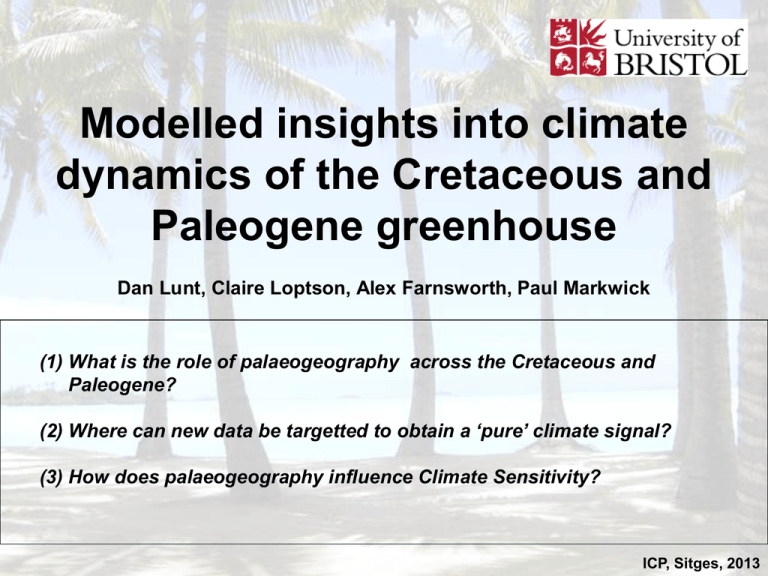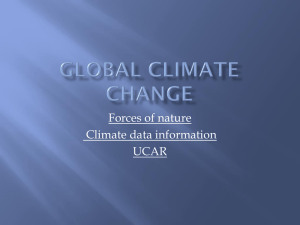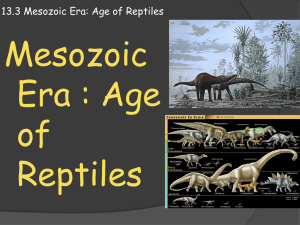Lunt_ICP_2013_no_animations
advertisement

Modelled insights into climate dynamics of the Cretaceous and Paleogene greenhouse Dan Lunt, Claire Loptson, Alex Farnsworth, Paul Markwick (1) What is the role of palaeogeography across the Cretaceous and Paleogene? (2) Where can new data be targetted to obtain a ‘pure’ climate signal? (3) How does palaeogeography influence Climate Sensitivity? ICP, Sitges, 2013 (1) Introduction Last 150 Ma: Major climate trends, + ‘events’ What is the role of solar forcing vs. palaeogeographic forcing vs. carbon cycle forcing? Data from Friedrich et al (2012) ICP, Sitges, 2013 (1) Introduction CO2 proxies Palaeogeography Solar forcing Maps from Scotese’s ‘Paleomap’ ICP, Sitges, 2013 (2a) Previous modelling work (paleogeography) ‘Real’ models... e.g. Westward flow through Tethys. Luyendyk et al, (1972) e.g. significant effect on temperature due to continental area (i.e. sea level), and potential importance of desert regions. Energy balance models... Barron et al (1980) ICP, Sitges, 2013 (2a) Previous modelling work (paleogeography) Atmosphere-only models... e.g. changes in high latitude land area and topography most important drivers... Barron and Washington (1984) e.g. Eastward flow through Tethys. Barron and Peterson (1990) Ocean-only models... e.g. Eocene (from SH) vs. Miocene (from NH) ocean overturning Bice et al (2000) ICP, Sitges, 2013 (2a) Previous modelling work (paleogeography) e.g. Atlantic rifting leads to warming, plus salinity changes usually interpreted as signalling middle Cretaceous warmth. Poulsen et al (2003) Intermediate complexity models... e.g. break-up of continent leads to increased seasonality Donnadieu et al (2006) ICP, Sitges, 2013 (2a) Previous modelling work (paleogeography) Atmosphere-ocean models... e.g. modelled Eocene meridional temperature gradients interpreted as being too great. Huber and Sloan (2001) e.g. modelled seasonality too large wrt. CLAMP, for 3 different Cretaceous palaeogeographies Spicer et al (2008) ICP, Sitges, 2013 (2a) Previous modelling work (CO2) e.g. Eocene climate sensitivity increases at higher temperatures – due to non-linearities in both forcing and cloud feedbacks. Caballero and Huber (in press) e.g. Cretaceous climate sensitivity enhanced due to vegetation feedbacks. Zhou et al (2012) ICP, Sitges, 2013 (3a) Questions to be addressed Current paradigm: Paleogeographical changes less important than greenhouse gas forcing. BUT: Work mostly focussed on a limited number of time periods Lack of consistency across simulations Coarse palaeogeographies Models have improved SO: (1)What is the role of palaeogeography across the Cretaceous/Paleogene? (2)Where can new data be targetted to obtain a ‘pure’ climate signal? (3)How does palaeogeography influence Climate Sensitivity? (i.e. “state dependency”). ICP, Sitges, 2013 (3b) Experimental Design Palaeogeographies provided by Getech and Paul Markwick Animation removed. Created using similar techniques to those outlined in Markwick (2007), based on published lithologic, tectonic and fossil studies, the lithologic databases of the Paleogeographic Atlas Project (University of Chicago), and deep sea (DSDP/ODP) data. Extensively updated from Markwick (2007), e.g. bathymetry, new rotations, more underlying data. ICP, Sitges, 2013 (3b) Experimental Design ICP, Sitges, 2013 (3b) Experimental Design The model: HadCM3L (with vegetation) “state-of-the-art”....not. ICP, Sitges, 2013 (3b) Experimental Design The model: HadCM3L How good is it for the palaeo? Lunt et al, Clim. Past (2012) Data compiled by Tom Dunkley Jones. ICP, Sitges, 2013 (3b) Experimental Design (consistent across all simulations) Phase 2 Phase 3 Phase 4 50-years 400-years 57-years 500-1000 years 4xCO2 TRIFFID Solar constants Ozone concentrations Lakes Deep ocean temperature Phase 1 Pre-industrial CO2 Pre-industrial SSTs Paleogeography's Uniform Veg Creation of islands Baratropic stremfunction No Ice + 2 x CO2 Ice + 2 x CO2 Ice + 4 x CO2 Simulation spinup – from Alex Farnsworth ICP, Sitges, 2013 (4) Results Global means... ICP, Sitges, 2013 (4) Results SSTs... e.g. Maximum warmth shifts from W. Pacific to E. Indian ocean in Late Eocene. Animation removed. Zonal mean relatively constant. ENSO is a constant feature. Winter Arctic and Southern Ocean seaice for all time periods. ICP, Sitges, 2013 (4) Results Regions of deep water formation... e.g. N. Pacific deep water formation in earliest Cretaceous, gone by Middle Cretaceous. Animation removed. Mid and late Cretaceous and early Eocene little mixing. North Atlantic deep water formation kicks off ~40 Ma. ICP, Sitges, 2013 (4) Results Vegetation... e.g. Expansive N and S American deserts in early Cretaceous. Animation removed. ‘Green’ Sahara develops in late Eocene. ICP, Sitges, 2013 (4) Results Single sites... ICP, Sitges, 2013 (4) Results Implications for site targetting... Where are the locations with least paleography-related change; i.e. Where to go for a ‘pure’ CO2 signal: Marine Terrestrial ICP, Sitges, 2013 (4) Results Climate Sensitivity Only one (two) ‘true’ sensitivity – Earth System Sensitivity. Either to (a) Wm-2 or (b) ΔCO2 This is neither! Modellers’ imagination ‘Charney’+vegetation. ICP, Sitges, 2013 (4) Results Climate Sensitivity 3.3oC 2.8oC 3.0oC 3.0oC 3.2oC 2.8oC 2.5oC ICP, Sitges, 2013 Summary Cretaceous and Paleogene simulations broadly support the paradigm that carbon cycle dominates over palaeogeography forcing. BUT, at single sites, the temperature changes due to palaeogeography alone can be very large. AND, other aspects of the system, such as ocean circulation and vegetation, can also show very large palaeogeographically-driven changes. Simulations can point to where a ‘pure’ CO2 signal could be obtained. Climate Sensitivity is a function of palaeography, varying by 30% through the late and mid Cretaceous. ICP, Sitges, 2013 (5) Future work CESM simulations Early Cretaceous grid Late Cretaceous grid Early Cretaceous DMS emissions Modern DMS emissions Modern DMS emissions “paleo-tised” Late Cretaceous DMS emissions ICP, Sitges, 2013 (5) Future work NERC project: Cretaceous-Paleocene-Eocene: Exploring Climate and Climate Sensitivity Complete CO2 sensitivities Ice sheets [e.g. role of CO2, gateways and ice sheets at E-O boundary] Model internal parameter sensitivity studies. Data compilations (Stuart Robinson, Oxford). Back-out model-derived CO2 record Sagoo et al, Phil Trans, in press. Kiehl et al, Phil Trans, in press. Lunt et al, Phil Trans, in press. . Equivalent future simulations ICP, Sitges, 2013 (5) Future work Complete Neogene simulations. Role of orbital forcing PMIP working group on ‘pre-Pliocene climates’ Joint venture between data and modelling communities Model output available. Email: d.j.lunt@bristol.ac.uk ICP, Sitges, 2013 Using the palaeo to inform the future Early Eocene, ~55 - 50 Ma Mid-Pliocene, ~3.3 - 3 Ma “Warm Climates of the Past – A lesson for the future?” Last Interglacial, 135-130 ka Special Issue of Phil Trans A All papers now ‘in press’ ...future, 2100 Including contributions from: Badger, DeConto, Dowsett, Foster, Hansen, Haywood, John, Kiehl, Lunt, OttoBliesner, Pagani, Pancost, Pearson, Sagoo, Valdes, Zachos, Zeebe, Zhang. Dan Lunt http://www.paleo.bris.ac.uk/~ggdjl/warm_climates.html ICP, Sitges, 2013 (4) Results Precipitation... e.g. Amazon desiccates in late Oligocene. East Asian monsoon system initiates in middle Eocene. Animation removed. North Atlantic storm tracks intensify in late Eocene. ICP, Sitges, 2013






